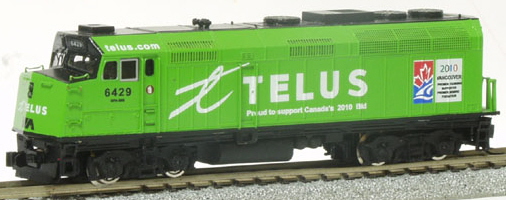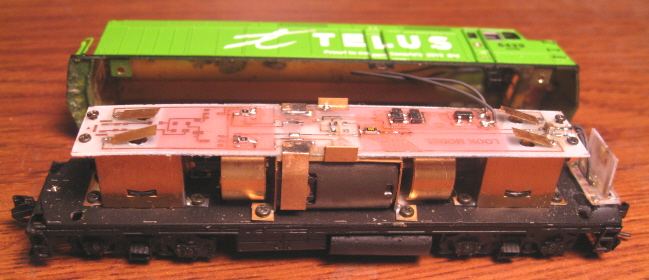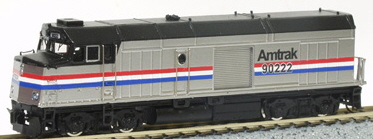

Introduced: circa 2007
I'm told that Look Model is/was a small "Mom & Pop" style operation (or maybe just "Pop") run out of Japan. As of this 2018 writing the Look Model website seems to have vanished, so perhaps Ken is no longer in business.
Anyway, this is an interesting model. Unfortunately, I don't think it really measures up to its $200 pricetag. To me it seems more like a really good amateur model, but not much more than that.

The chassis is brass and fairly minimalistic. I don't know the technical specs for the motor (poles, winding, etc). But based on the extremely high top-end speed, I'm assuming it's a 3-poler. Six of the eight wheels provide pickup (with one wheel per truck being equipped with a traction tire). The axles rub on stiff brass plates inside the truck assemblies, which then transfer current to sprung contacts on the PC board by way of long, skinny wipers. Contacts on the PC board then transfer current to the motor. The dual plastic driveshafts are each equipped with a flywheel and turn large brass worms inside of the truck towers. All the rest of the gearing is plastic. LED-equipped PC boards mounted inside the shell and on the front of the chassis provide directional lighting for the headlight, ditchlights and forward numberboards (there is no provision for lighting the rear boards). Micro-Trains couplers come preinstalled on the chassis. The trucks are a three-piece assembly of glued-together resin castings (side, side and bottom). Similarly, the fuel tank is a resin casting glued to the bottom of the chassis. Wheels are low-profile, so no problems on Code-55 rails.
Performance is just so-so. The large flywheels do make for nice, smooth throttle response and pickup seems adequate (no problems stalling, even through turnouts). Unfortunately, they're extremely loud (barbershop razor loud) and seem to run just a bit wobbly (no doubt owing to the traction tires and the overall light weight). Slow speed creep isn't anything to get excited about either. The motor seems to have a hard time getting those flywheels spun up, and by the time it decides to actually start moving, it's already moving too fast. The lighting is nice, but it goes way too far (lighting up the entire cab and also spilling out through the gaps in the bottom of the chassis). Another gripe is with the wheel gauging. Both of the Look Model locos I've tried have had their wheels gauged way too narrow. And to make matters worse, they're extremely difficult to adjust (you pretty much have to completely dismantle the trucks, grab the wheels on either end of a given axle with a couple of pliers and manhandle the bejeezus out of them in order to get them to budge).
The looks are just so-so as well. Yes, the paint and brass detailing are decent enough. Unfortunately, all of the graphics are clearly decals. Also unfortunate are the resin truck sideframes and fuel tank - fairly primitive looking to say the least.
So, not much to get excited about here. As mentioned above, I think this is a very fine amateur effort, but one that clearly doesn't measure up to professional standards. Is it worth the $200 pricetag? I guess that would be up to the individual modeler to decide, but personally, I say no.
On a side note, I got the impression somewhere along the line that these models are also available with preinstalled decoders. However, when I purchased mine I was not offered that option (and I forgot to ask about it). So, I dunno. Maybe they are and maybe they aren't. However, given the PC Board situation, I imagine that replacing it in favor of a decoder would be a pretty simple operation (assuming you can find one that has all the contacts in the right places).
Look Model also makes Amtrak "Cabbage" units. Prototypically speaking, said units were old F40's converted to cab control service - IE, they had their diesel engines removed. The extra space was then used for baggage (hence "cabbage"). And although the models are non-motorized dummies (ala the prototype), they do come with lighting (including blinking ditchlights on the DCC-equipped models). Having said all that, I've never actually owned one.

To remove the locomotive shell, unscrew the four tiny screws on the bottom of the chassis (just swivel the trucks out of the way to reveal them). Once said screws have been removed, the shell should lift right off.
Grade: C